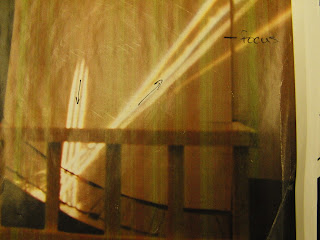It's always a hit with my classes, and the analysis has some surprising depth to it. A couple of my students in honors physics last year had the idea to blow this up, maybe even to a human sized version!
There were several great sticking points here, both in the analysis of the optics (both the top and the bottom of the thing are curved mirrors) and in the engineering. It took some time to figure out whether you're seeing a virtual image of a real image or a real image of a virtual image or... Even figuring out whether the observed image is from the top or bottom mirror is quite an issue.
They figured out these optical issues quite nicely:
The real show was in the engineering: figuring out how to build a parabolic or spherical form, and what the different effects of the two would be, was the first hurdle.
They did an awesome job demonstrating spherical aberration diagrammatically:
This told them that they'd need to modify the spherical mirrors of the demo (they figured out that they were spherical with some arc length measurements and tricky geometry).
Determining what material to use for the reflective surface was also a challenge. They started with a proof-of-concept model, somewhat larger than the original, but not near the intended scale. They went through mylar, plastic, and a few other materials, and settled on cutting small sections of flexible mirror and gluing them to the smooth surface of the model.
The whole idea of proof-of-concept is one of the great things here: they're doing real work, which means that you don't exactly know how it'll come out, so showing that it's possible is (economically, effort-, and time-wise) bright - you don't want to waste a huge chunk of time on something that clearly can't work (though it's only clear after the fact!).
Ultimately, the focus wasn't crisp enough to form any sort of credible image, but they used a ray box to investigate exactly how the rays were traveling - close to convergence, but not close enough to see an image. They demonstrated the success of the geometric design, and pinpointed the issue in surface material/design.
...did I mention that only one of these students had studied optics? (He took physics the year before, which covers optics, and then took honors physics the next year)




No comments:
Post a Comment